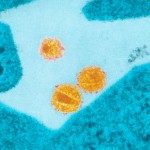Lien vers Pubmed [PMID] – 28993513
J. Immunol. 2017 Nov;199(10):3437-3452
Rare patients who spontaneously control HIV replication provide a useful model to inform HIV vaccine development. HIV controllers develop particularly efficient antiviral CD4+ T cell responses mediated by shared high-affinity TCRs. To determine whether the candidate DNA vaccine ADVAX could induce similar responses, we analyzed Gag-specific primary CD4+ T cells from healthy volunteers who received ADVAX DNA by electroporation. Vaccinated volunteers had an immunodominant response to the Gag293 epitope with a functional avidity intermediate between that of controllers and treated patients. The TCR repertoire of Gag293-specific CD4+ T cells proved highly biased, with a predominant usage of the TCRβ variable gene 2 (TRBV2) in vaccinees as well as controllers. TCRα variable gene (TRAV) gene usage was more diverse, with the dominance of TRAV29 over TRAV24 genes in vaccinees, whereas TRAV24 predominated in controllers. Sequence analysis revealed an unexpected degree of overlap between the specific repertoires of vaccinees and controllers, with the sharing of TRAV24 and TRBV2 public motifs (>30%) and of public clonotypes characteristic of high-affinity TCRs. MHC class II tetramer binding revealed a broad HLA-DR cross-restriction, explaining how Gag293-specific public clonotypes could be selected in individuals with diverse genetic backgrounds. TRAV29 clonotypes also proved cross-restricted, but conferred responses of lower functional avidity upon TCR transfer. In conclusion, DNA vaccination by electroporation primed for TCR clonotypes that were associated with HIV control, highlighting the potential of this vaccine delivery method. To our knowledge, this study provides the first proof-of-concept that clonotypic analysis may be used as a tool to monitor the quality of vaccine-induced responses and modulate these toward “controller-like” responses.

